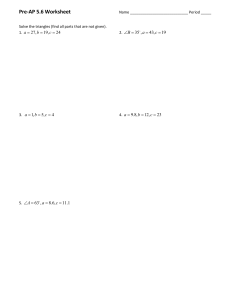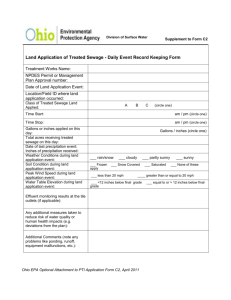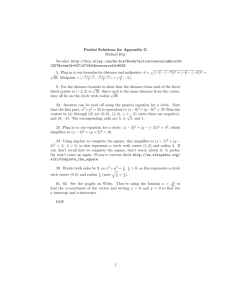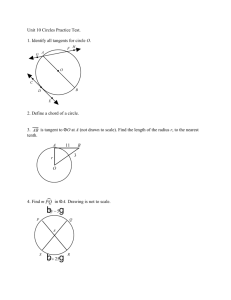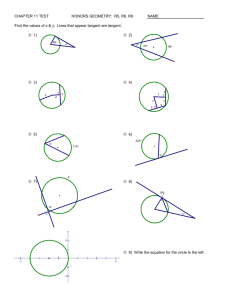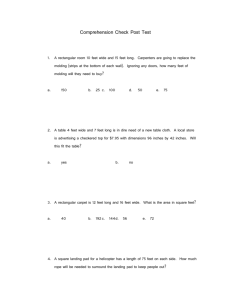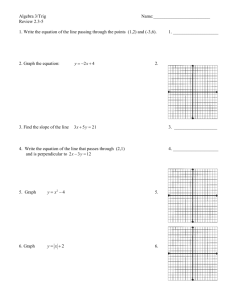Answer Explanations for: SAT May 2012 Section 8
advertisement
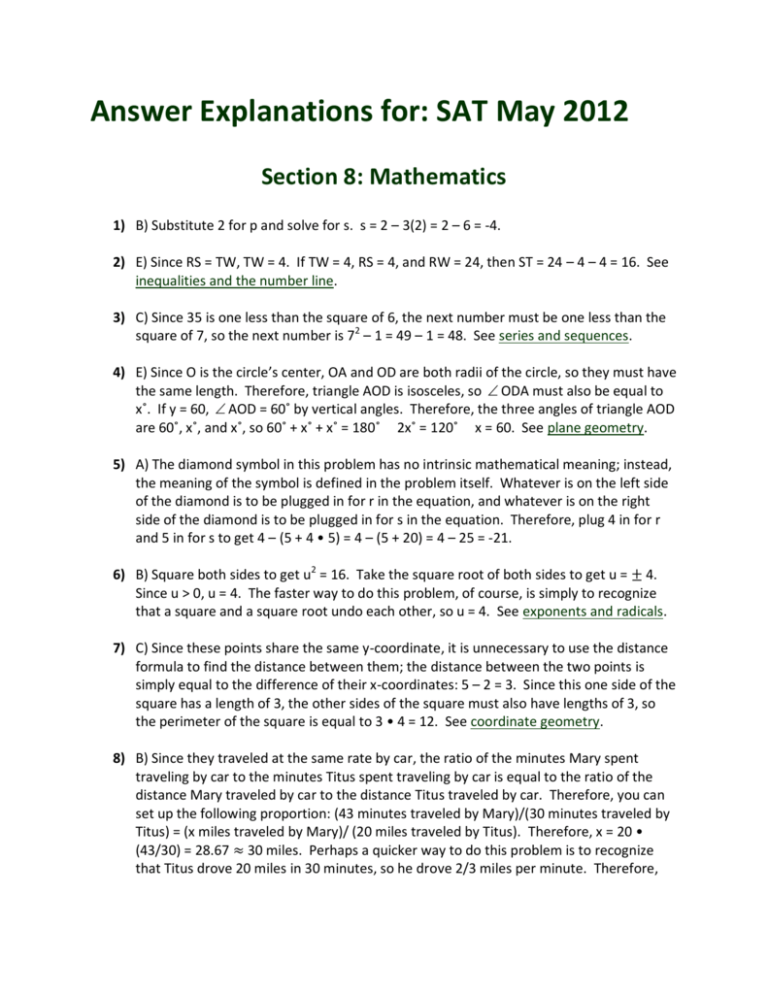
Answer Explanations for: SAT May 2012 Section 8: Mathematics 1) B) Substitute 2 for p and solve for s. s = 2 – 3(2) = 2 – 6 = -4. 2) E) Since RS = TW, TW = 4. If TW = 4, RS = 4, and RW = 24, then ST = 24 – 4 – 4 = 16. See inequalities and the number line. 3) C) Since 35 is one less than the square of 6, the next number must be one less than the square of 7, so the next number is 72 – 1 = 49 – 1 = 48. See series and sequences. 4) E) Since O is the circle’s center, OA and OD are both radii of the circle, so they must have the same length. Therefore, triangle AOD is isosceles, so ODA must also be equal to x˚. If y = 60, AOD = 60˚ by vertical angles. Therefore, the three angles of triangle AOD are 60˚, x˚, and x˚, so 60˚ + x˚ + x˚ = 180˚ 2x˚ = 120˚ x = 60. See plane geometry. 5) A) The diamond symbol in this problem has no intrinsic mathematical meaning; instead, the meaning of the symbol is defined in the problem itself. Whatever is on the left side of the diamond is to be plugged in for r in the equation, and whatever is on the right side of the diamond is to be plugged in for s in the equation. Therefore, plug 4 in for r and 5 in for s to get 4 – (5 + 4 • 5) = 4 – (5 + 20) = 4 – 25 = -21. 6) B) Square both sides to get u2 = 16. Take the square root of both sides to get u = 4. Since u > 0, u = 4. The faster way to do this problem, of course, is simply to recognize that a square and a square root undo each other, so u = 4. See exponents and radicals. 7) C) Since these points share the same y-coordinate, it is unnecessary to use the distance formula to find the distance between them; the distance between the two points is simply equal to the difference of their x-coordinates: 5 – 2 = 3. Since this one side of the square has a length of 3, the other sides of the square must also have lengths of 3, so the perimeter of the square is equal to 3 • 4 = 12. See coordinate geometry. 8) B) Since they traveled at the same rate by car, the ratio of the minutes Mary spent traveling by car to the minutes Titus spent traveling by car is equal to the ratio of the distance Mary traveled by car to the distance Titus traveled by car. Therefore, you can set up the following proportion: (43 minutes traveled by Mary)/(30 minutes traveled by Titus) = (x miles traveled by Mary)/ (20 miles traveled by Titus). Therefore, x = 20 • (43/30) = 28.67 30 miles. Perhaps a quicker way to do this problem is to recognize that Titus drove 20 miles in 30 minutes, so he drove 2/3 miles per minute. Therefore, you can simply multiply 2/3 by the minutes Mary traveled by car to find how many miles she drove. See ratios and proportions. 9) D) If w is increased by 2 and w is multiplied by 3, k is increased by 2 • 3 = 6. A more algebraic way of thinking about it is that after the increase, k is equal to 3(w + 2) + 2 = 3w + 6 + 2, which is 6 more than the initial value of k. 10) A) When a point is reflected across the x-axis, its x-value remains the same, and the sign of its y-value is reversed (meaning that a positive y-value becomes negative and a negative y-value becomes positive). g(2) refers to the y-value when x = 2 in function g. First, find f(2), the y-value when x = 2 in function f, by looking at the graph. Since y = 2 when x = 2 on the graph, f(2) = 2. Because g is f reflected across the x-axis, the sign of this y-value is reversed, so g(2) = -2. See coordinate geometry and function notation. 11) A) You are trying to find the inches per year, so you should divide the inches by the years, since per indicates division. 60 inches / 200 years = 3/10 inches per year. If you got any of the other answers, you should have second guessed your answer for not making sense. If 200 years are represented by 60 inches, multiple years will have to fit into every inch, so each year will have to be represented by less than one inch. Alternatively, you could have done this problem by setting up a proportion. To make sure you set it up right, make sure the units line up on both sides. In other words, this/that = this/that. Here, you have (inches)/(years) = (inches)/(years). 60 inches/200 years = x inches/1 year. x = 60/200 = 3/10 inches. See ratios and proportions. 12) C) To get this problem correct, it helps to understand a bit of basic logic. If you have an original statement “If A, then B,” then its inverse is “If B, then A,” its converse is “If not A, then not B,” and its contrapositive is “If not B, then not A.” If the original statement is true, then its contrapositive is necessarily true, but you cannot draw any conclusions about the truth or falsehood of the inverse or converse. Therefore, C is the correct answer, since it represents the contrapositive of the original statement. A represents the inverse of the original statement, and E represents the converse of the original statement. B represents a statement that is not necessarily true, while D represents a statement that cannot be true. Even if you have not studied logic, you can get this problem right just by reasoning through it. The original statement implies that all numbers in list X are also in list Y, indicating that it is impossible for a number to be in list X without also being in list Y, so C must be true. 13) E) The median of a set is the term in the set with the same number of terms greater than it and less than it. The easiest way to find the median of a set is to cross of the least term and the greatest term repeatedly until only one term remains. In a set with an even number of terms, the two terms that are left are then averaged to produce the median, but in a set with an odd number of terms, like the set in the question, this is not necessary, since only one term will be left after this process. One tricky thing about this problem is that the age of the oldest member of the group is completely unnecessary, so don’t let this bit of information cause you to overthink things. I works because there could be 3 17 year olds, 6 students older than 17, and 6 students younger than 17. II works because there could be 10 17 year olds, 2 students older than 17, and 3 students less than 17, which would still yield a median of 17. III works because there could be 14 17 year olds, 1 student older than 17, and 0 students younger than 17, which again would still yield a median of 17. See averages. 14) D) Use the Pythagorean Theorem to relate the sides of the right triangle and solve for x. x2 = (r2 + t2) )2 – s2 = r2 + t2 – s2. Take the square root of both sides to find x. x = (r2 + t2 – s2). See right triangles and exponents and radicals. 15) D) Build an equation based on the information in the question, remembering that is means equals and more than means addition: 6j = k2 + 1. Now divide both sides by 6 to get j = (k2 + 1)/6. Because you are trying to minimize j, you must minimize the numerator of the fraction on the right-hand side of the equation. Therefore, you must minimize the value of k2, keeping in mind that k must be an integer. The smallest value of k2 occurs when k = 0, since when k = 0, k2 = 0, so j = (0 + 1)/6 = 1/6. See number properties and equation building. 16) E) 32 – 1 = 8 = 800%. To clarify, the equation for the area of a circle is πr2, so the area of a circle varies directly by the square of its radius. Therefore, tripling the radius creates a new circle with an area 32 = 9 times that of the original. However, precisely speaking, it increases the area of the original by 8 times (800%) since the new area is 9 times that of the original and the area of the original was already 1 times (100% of) the area of the original circle. A less abstract approach to this problem would be to choose a number for the radius of the original circle. Let’s say it has a radius of 1. Therefore, the area of the original circle is 12 • π = π. If the radius was made 3 times as big, the circle would have a radius of 3, so its area would be 32 • π = 9π, which would be an increase of 8π from the original circle. This increase of 8π would be an increase of 800%, since 8π is 8 times π, the area of the original circle.
